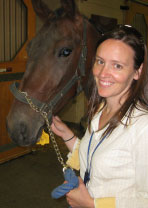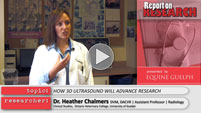ARCHIVE EQUINE NEWS STORIES
| Current news is available at TheHorsePortal.ca, Equine Guelph's online learning platform for practical, quick learning. Given the vast amount of information on horse health and welfare, Equine Guelph has archived its past news articles from 2002-2020. They are listed below, along with a search function available to find specific healthcare topics. | |
3D Ultrasound Adds a New Dimension to Research into RoaringSeptember 2012
 You have seen the marvels of 3-D cinema whether it was Thor’s hammer hurling toward you or maybe it was Superman Returns at the IMAX. Ultra sound technology has also developed 3 – D capabilities and it is evolving faster than a speeding bullet, with more accuracy than a CAT scan. What this means for researchers is a more detailed picture when making diagnosis and an accurate, simple way to track the results of treatment modalities potentially without using a more invasive biopsy.
You have seen the marvels of 3-D cinema whether it was Thor’s hammer hurling toward you or maybe it was Superman Returns at the IMAX. Ultra sound technology has also developed 3 – D capabilities and it is evolving faster than a speeding bullet, with more accuracy than a CAT scan. What this means for researchers is a more detailed picture when making diagnosis and an accurate, simple way to track the results of treatment modalities potentially without using a more invasive biopsy.
With a recent donation from the Equine Foundation of Canada, University of Guelph researcher, Dr. Heather Chalmers, is able to add a new dimension to her research focusing on early screening of roaring and may lead to earlier treatment. Roaring, or laryngeal paralysis, is a very common disease which can affect any breed or discipline of horse. This progressive disease results in the inability to open the upper airway at exercise which limits performance and actually leads to a roaring sound. Owners who hear a gurgling sound or an increase in noise when the horse is breathing are encouraged to seek veterinary advice.
The goal of Chalmers’ research is to provide horse owners with a reliable, easy, readily available and inexpensive way to screen horses for roaring prior to clinical signs of the disease. This allows horse owners or a potential horse purchaser to career plan for their horses, determining potential or limiting factors. Chalmers’ is very excited about the donation of new equipment this past summer, “When it comes to ultrasound - 3D allows us to look at the tissues in greater detail, to get a more accurate assessment of the size and exact location of abnormalities and to monitor them accurately over time.”
Assessing the size of the upper airway muscles helps researchers understand more about their function and disease status. Chalmers explains, “We know from our own experience, working out in the gym, a muscle that gets bigger is stronger and more functional. After interventions the ultra sound will be able to keep track of changes to see if the smaller diseased muscle has responded with an increase in size.”
The next step in Chalmers’ research is to solidify the long suspected link between what is seen on the ultrasound screen and what can be found under the microscope if a biopsy were performed.
It is important to fully establish:
3-D Ultrasound is helping researchers understand all three of these questions.
Research funding has been provided by Equine Guelph, American College of Veterinary Radiology, Medel Austria, Robarts Imaging Institute at the University of Western Ontario and The Equine Foundation of Canada.
Read - Dr. Heather Chalmers biography & Published Papers
Funding for the Report on Research and Help for Horse Owners videos has been provided by the Knowledge Translation and Transfer Program under the OMAFRA-U of G Partnership.

